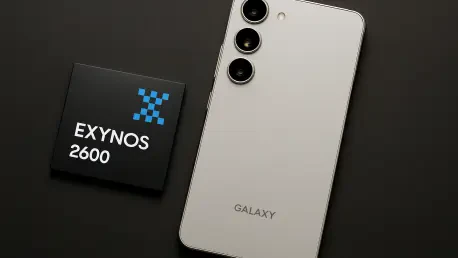What happens when a tech giant bets big on its own innovation to challenge industry titans? Samsung is doing just that with the Exynos 2600 chipset, unveiled as the heart of the Galaxy S26 series, promising a smartphone that runs faster, stays cooler, and doesn’t drain the battery during intense gaming or multitasking. This isn’t just a promise—it’s the ambition driving Samsung’s latest move. With the Exynos 2600, the company aims to redefine flagship performance and carve out a stronger foothold in the cutthroat semiconductor market.
Why This Chip Changes Everything
The Exynos 2600 isn’t merely an upgrade; it’s a statement of intent. As smartphones evolve into pocket-sized powerhouses, the chipset inside determines the user experience—speed, efficiency, and reliability all hinge on this tiny piece of silicon. Samsung’s decision to power the Galaxy S26 series, including the flagship S26 Ultra, with its in-house processor marks a pivotal shift. It’s about proving that proprietary technology can rival or even surpass external heavyweights like Qualcomm’s Snapdragon.
This development carries weight beyond a single device lineup. Industry reports from Daishin Securities confirm mass production of the Exynos 2600 has kicked off, utilizing Samsung’s cutting-edge 2nm Gate All Around (GAA) node. The stakes are high—success here could bolster confidence in Samsung’s ability to innovate independently, reducing reliance on third-party suppliers while addressing consumer demands for longer-lasting, high-performing devices.
Samsung’s Bigger Play in the Chip Game
The tech landscape is a battlefield, and chip supremacy is the prize. Samsung’s push with the Exynos 2600 reflects a broader strategy to strengthen its semiconductor division against competitors like TSMC. By doubling down on in-house chip design, the company aims to cut costs and gain flexibility in pricing, a move that could ripple through the market. This isn’t just about smartphones; it’s about positioning Samsung as a go-to player in the global foundry business.
Challenges loom large, though. The foundry segment is projected to post a KRW 1.3 trillion loss in Q3, though that’s an improvement from the previous quarter’s KRW 2.6 trillion deficit. Yet, partnerships with giants like Nintendo for the Switch 2 chip and Tesla through a $16.5 billion AI chip deal signal potential growth. These collaborations hint at Samsung’s ambition to attract external clients, especially as TSMC’s pricing climbs, creating an opening for market share gains.
Inside the Exynos 2600: Tech That Packs a Punch
Dive into the Exynos 2600, and it’s clear Samsung has pulled out all the stops. Built on the advanced 2nm GAA node, this chipset prioritizes efficiency without sacrificing raw power. A standout feature, the Heat Pass Block element, tackles a persistent pain point—overheating during heavy use. This innovation promises a cooler device even under demanding conditions like 4K video streaming or extended gaming sessions.
Performance metrics are equally impressive. Early Geekbench results reveal the integrated Xclipse 960 GPU might outshine Qualcomm’s Snapdragon 8 Elite Gen 5 in graphics capabilities. Following the cost-effective rollout of the Exynos 2500 in the Galaxy Z Flip7, this new chipset balances premium features with affordability. It’s a bold bid to compete in the high-end market while keeping flagship devices accessible to a wider audience.
Industry Buzz: High Hopes and Hard Realities
Voices from within Samsung and beyond are abuzz with anticipation. Leadership at Samsung LSI has expressed unwavering confidence, emphasizing “thorough preparation” and expectations of significant impact with the Exynos 2600. Analysts align with this optimism, suggesting that Samsung could narrow the gap with leading chipmakers if the chipset delivers on its promises. Reports from Daishin Securities highlight a potential domino effect—success could draw external clients to Samsung’s foundry services.
However, not all feedback is unqualified. The financial strain on the foundry business remains a concern, with losses still in the billions. While the Device Solutions division anticipates a Q3 operating profit of KRW 5 trillion, driven largely by memory chips at KRW 6.3 trillion, the Exynos 2600’s rollout is seen as a high-stakes gamble. Its performance in real-world scenarios will be the ultimate test of Samsung’s semiconductor aspirations.
What Galaxy S26 Users Can Expect
For those eyeing the Galaxy S26 series, the Exynos 2600 brings tangible upgrades. Imagine seamless multitasking or marathon gaming without the device turning into a hand warmer—improved thermal management makes this a reality. Users can also anticipate flagship-level performance without the premium price tag, thanks to Samsung’s focus on cost efficiency in chip production. It’s a win for both casual users and tech enthusiasts.
Beyond immediate benefits, this chipset hints at broader implications. Keep tabs on early reviews of the Galaxy S26 lineup for hands-on insights into battery life and speed compared to Snapdragon-equipped rivals. Additionally, Samsung’s growing ties with companies like Tesla and Nintendo suggest the Exynos technology could influence diverse industries, from electric vehicles to gaming consoles. This isn’t just about a phone—it’s about the future of connected tech.
Reflecting on a Defining Moment
Looking back, Samsung’s unveiling of the Exynos 2600 stood as a turning point, blending innovation with strategic risk-taking. The chipset’s integration into the Galaxy S26 series showcased a commitment to redefining mobile performance through in-house expertise. Despite financial hurdles in the foundry segment, the groundwork laid through partnerships and technological advancements pointed toward recovery and growth.
The next steps were clear for industry watchers and consumers alike. Tracking real-world feedback on the Galaxy S26 devices became essential to gauge the chipset’s true impact. Exploring how Samsung leveraged its collaborations with global tech leaders offered clues about the broader applications of Exynos technology. Ultimately, this chapter in Samsung’s story underscored a relentless drive toward independence and influence in the semiconductor realm, setting the stage for transformative developments ahead.









